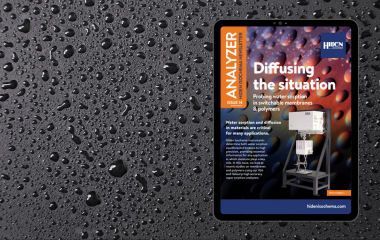How Does a Dynamic Vapour Sorption Analyser Work?
Dynamic vapour sorption (DVS) analysis is a pivotal technique in materials science. It plays an instrumental role in characterising the interactions between vapours, primarily water vapor, and solid samples. This article delves into the works of a dynamic vapour sorption analyzer, exploring its principles, components, and applications in various scientific industries.
Fundamental Principles of Dynamic Vapour Sorption
Dynamic vapour sorption analyses the sorption and desorption processes of vapours on solids. It measures the mass change that occurs when a sample interacts with a controlled gas environment.
This tool works by analysing a sample’s gravimetric equilibrium. Any changes in the sample mass are meticulously recorded as it is exposed to varying concentrations of vapour. Usually, it is for water vapour sorption, but it can be used for other species, like organic solvents. A DVS instrument can also be used with organic vapours.
Key Components of a Dynamic Vapour Sorption Analyser
- Microbalance: At the heart of a dynamic vapour sorption analyser is a highly sensitive microbalance that is capable of detecting minute changes in mass (in the microgram range). The sample is suspended from the microbalance in a controlled temperature environment.
- Temperature Control Unit: Precise temperature control is crucial as temperature variations can significantly influence sorption behavior. Modern DVS systems offer a wide range of temperature settings to accommodate a variety of materials.
- Vapour Generation and Control System: This system precisely regulates the concentration and flow of vapour exposed to the sample. Different sorption conditions are systematically tested through decreased and increased humidity levels and flow rates.
- Data Analysis Software: Advanced software is employed to record and interpret data. This includes the calculation of vapour sorption isotherms and kinetics. These kinetics and isotherms show the material’s properties, which demonstrates how crucial they are.
The Analytical Process of a Dynamic Vapour Sorption Analyser:
- Sample Preparation: The sample is prepared and placed in the sample pan attached to the microbalance. This is normally in a powdered or granular form, but can be in the form of thin films, monoliths, or other forms.
- Baseline Establishment: A baseline weight is established under dry conditions or a defined initial environment.
- Vapour Exposure: The sample is then exposed to controlled vapour concentrations. The microbalance records weight changes corresponding to the adsorption or desorption of the vapour.
- Data Collection and Analysis: Continuous data collection is used over the course of the experiment. It allows for the analysis of sorption kinetics and the creation of vapour sorption isotherms.
- Final Evaluation: The final data provides insights into the material’s properties. Examples of these properties are pore size distribution, surface area, and interaction strength with the vapour.
Applications in Scientific Industries
A dynamic vapour sorption analyser can be used across various scientific domains. Applications include:
- Pharmaceutical Industry: In pharmaceuticals, DVS is crucial for understanding the stability and shelf life of drugs. This is because moisture interaction can significantly impact these factors.
- Material Science: It aids in characterising materials like zeolites, clays, and polymers, especially in understanding their porosity and surface properties.
- Food Science: The technique is used to examine food product stability, moisture content, and shelf life. These are vital for quality control.
- Environmental Science: Studying soil and sediment interactions with moisture or pollutants is facilitated by DVS, providing insights into environmental processes.
Advantages and Limitations
Advantages
- Precision and Sensitivity: The high sensitivity of microbalances makes DVS a highly precise method for studying sorption phenomena.
- Versatility: Applicable to a wide range of materials and industries.
- Quantitative Data: Provides detailed quantitative information on moisture interaction, which is essential for material characterisation.
Limitations
- Sample Size and Type: This method is limited by the size and nature of the sample that can be analysed.
- Time-Consuming: Some DVS experiments can be lengthy, particularly when equilibration times are long. However, Hiden Isochema’s unique kinetic trend analysis feature allows equilibration times to be adapted automatically to the measured sorption kinetics, giving more accurate results in a shorter time.
- Complex Data Interpretation: The interpretation of DVS data requires a deep understanding of material properties and sorption phenomena.
Dynamic vapour sorption analysis is a robust and versatile technique that is essential in the characterisation of material-gas interactions. Its precision and applicability across various scientific fields makes it an indispensable tool in both research and industry settings. However, its effectiveness is contingent on careful sample preparation, precise instrumentation, and expert interpretation of complex data sets.
Future Directions and Technological Advancements
The future of DVS instruments is looking bright because of significant advancements with its technology. This includes:
- Integrating more sophisticated control systems
- Utilising enhanced data analysis algorithms
- Potentially combining the instruments with other analytical techniques.
Innovations in sensor technology and automation are expected to reduce analysis times and improve the sensitivity and accuracy of measurements. Furthermore, the application of machine learning and artificial intelligence in data interpretation could revolutionise the way we understand complex sorption processes.
Paving the Way Forward with Dynamic Vapour Sorption Analysis
Dynamic vapour sorption analysis represents a convergence of precision engineering, advanced material science, and analytical chemistry. Its ability to provide detailed insights into material-vapour interactions underpins its crucial role in various scientific and industrial applications.
While there are challenges associated with its use, the ongoing technological advancements and the increasing need for detailed material characterisation ensure that a dynamic vapour sorption analyser will remain a key tool in the scientific community’s arsenal.
Ready to use a Dynamic Vapour Sorption Analyser?
Hiden Isochema would like to present the IGAsorp. This is our fully automated, compact benchtop DVS analyser that can help you measure the change in the mass of your sample.
The IGAsorp is not just a dynamic vapour sorption analyser. It acts as a gateway to a deeper understanding of material properties under a range of environmental conditions. As an embodiment of Hiden Isochema’s commitment to excellence, it offers diffusion coefficients for unrivalled analysis and performance, total baseline stability, and a 3-year warranty that underscores its reliability.
With the IGAsorp, you are not just conducting experiments; you are pioneering research and quality control with a tool that ensures the fast and accurate analysis of equilibria and kinetics by using the unique IGA method.
Embrace the future of material science and elevate your research capabilities with a dynamic vapour sorption analyser from Hiden Isochema. You can find out more about the IGAsorp and discover how this state-of-the-art technology can be an invaluable asset to your scientific endeavors.
For further information or to request a quote, Hiden Isochema’s team of experts is just a click away. We are ready to assist and guide you through the intricate world of dynamic vapour sorption analysis. Get in Touch


